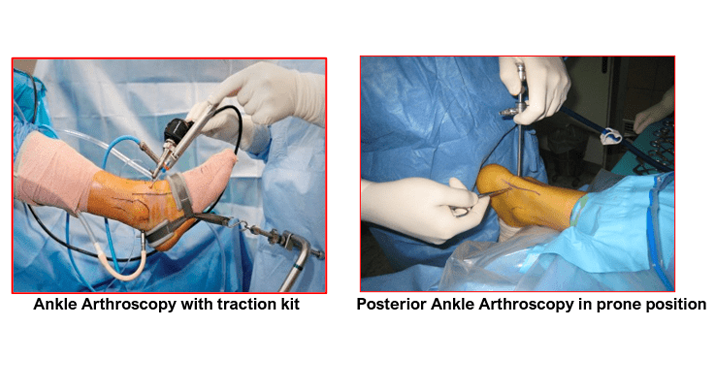Ankle arthroscopy is a minimally invasive surgical procedure used to diagnose and treat a wide range of ankle joint problems. It involves the use of a small fiber-optic camera (arthroscope) inserted through tiny incisions around the ankle, allowing orthopedic surgeons to view the inside of the joint on a monitor and perform corrective procedures with high precision.
Due to its minimally invasive nature, ankle arthroscopy has become a preferred option for treating various conditions that cause pain, swelling, stiffness, or instability in the ankle. It allows faster recovery, minimal tissue damage, and reduced post-operative complications compared to traditional open surgery.
Why Ankle Arthroscopy?
Ankle injuries are common among athletes and active individuals, but they can also affect the general population due to trauma, repetitive stress, or degenerative changes. When non-surgical treatments like rest, medication, and physical therapy fail to relieve symptoms, ankle arthroscopy may be recommended.
Common Conditions Treated with Ankle Arthroscopy
- Anterior Ankle Impingement
Bony or soft tissue overgrowth at the front of the ankle can restrict movement and cause pain during activities like squatting or climbing stairs. Arthroscopy removes the impinging tissue or bone spur to restore mobility.
- Osteochondral Lesions (Cartilage Damage)
Damage to the cartilage and underlying bone, often due to ankle sprains or fractures, may cause persistent pain and swelling. Arthroscopy helps clean the damaged area and may include procedures like micro fracture or drilling to stimulate cartilage healing.
- Loose Bodies
Fragments of bone or cartilage can float within the joint, causing locking, catching, or pain. These can be located and removed arthroscopically.
- Synovitis
Inflammation of the synovial lining of the joint due to arthritis, trauma, or autoimmune conditions can cause swelling and stiffness. Arthroscopy allows removal of inflamed tissue (synovectomy).
- Ankle Instability
Chronic instability due to repeated sprains may involve ligament damage or impingement. Arthroscopy is often used in conjunction with ligament repair or reconstruction procedures.
- Arthrofibrosis
Excess scar tissue within the joint can restrict motion and cause discomfort. Arthroscopy helps release the scar tissue and restore range of motion.
- Infection (Septic Arthritis)
Ankle arthroscopy can be used to clean the joint in cases of infection, providing both diagnostic and therapeutic benefits.
The Procedure
- Preparation: Performed under spinal or general anesthesia
- Incisions: 2–3 small incisions (portals) are made around the ankle
- Visualization: An arthroscopy transmits live images from inside the joint
- Treatment: Specialized instruments are used to repair, remove, or reconstruct tissues as needed
- Duration: Usually 30–90 minutes depending on the complexity
Postoperative Recovery
Recovery from ankle arthroscopy varies based on the procedure performed, but general expectations include:
- Outpatient basis: Most patients go home the same day.
- Weight-bearing: May require crutches or a boot for 1–4 weeks
- Physical therapy: Starts early to restore mobility, strength, and stability
- Return to activity:
• Light activity: 2–4 weeks
• Sports or high-impact activity: 8–12 weeks or more
Adherence to a structured rehabilitation program is crucial for optimal outcomes.
Benefits of Ankle Arthroscopy
- Minimally invasive with small incisions
- Less post-operative pain and swelling
- Lower infection risk
- Faster return to normal activity
- Precise diagnosis and targeted treatment of joint pathology
Is Ankle Arthroscopy Right for You?
Candidates for ankle arthroscopy include:
- Individuals with chronic ankle pain unresponsive to conservative treatment
- Athletes with unresolved ankle injuries
- Patients with cartilage lesions, instability, or impingement syndromes
- Individuals needing joint debridement or loose body removal
A thorough clinical evaluation, imaging studies (MRI/CT), and consultation with an orthopedic surgeon will determine the best course of treatment.






